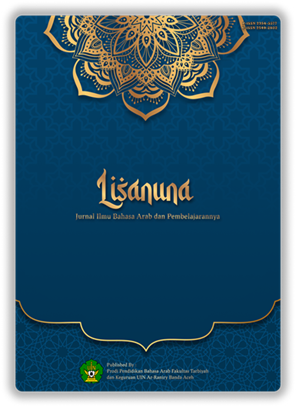منهج المواد الدراسية في تعليم اللغة العربية للناطقين بغيرها
DOI:
https://doi.org/10.22373/ls.v14i2.26700Keywords:
Curriculum, Subject Matter, Arabic LanguageAbstract
The Arabic language holds an exceptional position in history, culture, and religion. Studying Arabic is not limited to understanding classical and contemporary literary works from the Arab world, but also provides access to knowledge and thought in various fields of science such as history and the sciences. Arabic also plays a crucial role in religion, as the Quran, the holy book of Islam, is written in Arabic. Educational curriculum is a structured plan or program that includes a series of subjects and educational activities designed to achieve specific educational goals. It encompasses various aspects of the learning process, including learning objectives, teaching strategies, performance assessment, and evaluation. The primary goal of educational curriculum is to provide guidance and direction for the learning process so that students can achieve their full potential. Subject matter curriculum is an approach in curriculum design that emphasizes teaching subjects separately. In this model, each subject is taught as an independent and separate unit, without attempting to link the subjects together. Subject matter curriculum places greater emphasis on understanding concepts and facts in each discipline deeply.References
Abd Wahab Rosyidi, dan Namlu’atul Ni’mah. 2011. Memahami Konsep Dasar Pembelajaran Bahasa Arab, Malang: UIN Malik Press.
Ahmad, dkk. 1998. Pengembangan Kurikulum. Bandung: Pustaka Setia.
Ali, Muhammad. 2005. Pengembangan Kurikulum di Sekolah. Bandung: Sinar Baru Algesindo.
Anwar, Syaiful, dan Tayar Yusuf. 1997. Metodologi Pengajaran Agama dan Bahasa Arab, Jakarta: Raja Grafindo Persada.
Arifin, Zainal. 2011. Konsep dan Model Pengembangan Kurikulum. Bandung: Remaja Rosda Karya.
Dakir. 2004. Perencanaan dan Pengembangan Kurikulum. Jakarta: Rineka Cipta.
Faisal, Sanapiah. 1982. Metodologi Penelitian Pendidikan, Surabaya: Usaha Nasional.
Hafnidar, H., & Falah, M. F. (2023). Taṭwīr Māddah al-Kitābah Fī Kitāb Bahasa Arab Madrasah Aliyah 2020 Bi Biṭṭāqah at-Takammulah Li Tarqiyah Qudrah aṭ-Ṭālibāt `Alā Tarkīb al-Jumal al-Mufīdah Bi Ma`had Darul Muta`allimīn Meulaboh: Darul Muta’allimin Meulaboh ببطاقة التكملة لترقية قدرة الطالبات على تركيب الجمل المفيدة بمعهد Bahasa Arab Madrasah Aliyah 2020 تطوير مادة الكتابة في كتاب . EL-MAQALAH Journal of arabic language teaching and linguistics, 4(2) https://doi.org/10.22373/maqalah.v4i2.3802
Hamalik, Oemar. 2005. Kurikulum dan Pembelajaran, Jakarta: Bumi Aksara.
Hamid, Mas’an. 1995. Ilmu Arudl dan Qawafi. Surabaya: Al-Ikhlas.
Idi, Abdullah. 2007. Pengembangan Kurikulum Teori dan Praktik, cet. II. Jogjakarta: Ar-Ruzz Media.
Muslim, Buhori, & Syarifuddin Hasyim. (2018). Implementasi UU No. 12 Tahun 2012 dan PP No. 8 Tahun 2012 Terhadap Pengembangan Kurikulum Program Studi Pendidikan Bahasa Arab Fakultas Tarbiyah dan Keguruan UIN Ar-Raniry Banda Aceh. LISANUNA: Jurnal Ilmu Bahasa Arab dan Pembelajarannya, 8(2), https:// DOI: http://dx.doi.org/10.22373/ls.v8i2.4560
Muthohar, Ahmad. 2011. Gagasan Konsentrasi Pembidangan Jurusan Pendidikan Agama Islam Fakultas Tarbiyah, Jurnal: INSANIA, vol. 16, no. 3. 2011, h. 273-276.
Nasution, 1999. Kurikulum dan Pengajaran. Jakarta: Bumi Aksara
---, S. 1995. Asas-Asas Kurikulum. Jakarta: Bumi Aksara.
Neil, John D.MC. 1998. Curriculum: a Comprehensive Introduction. Canada: Little Brown & Company.
Nurdin, Syafruddin. 2005. Guru Profesional Dan Implementasi Kurikulum. Jakarta: Quantum Teaching.
Oliva, Peter f. 1982. Developing the Curriculum. Canada: Little, Brown & Company.
Samak, Muhammad Sholeh.1998. Fannu Tadris. Kairo: Darul Fikr al-Arab
Subandiyah. 1993. Pengembangan dan Inovasi Kurikulum. Jakarta: Grafindo Persada.
Sudjana, Nana. 2002. Pembinaan dan Pengembangan Kurikulum di Sekolah. Bandung: Sinar Baru Algesindo.
Sugiana, Aset. 2018. Proses Pengembangan Organisasi Kurikulum di Indonesia. El-Hikmah: Jurnal Kajian Dan Penelitian Pendidikan Islam, 12(1), 91–103.
Sukmadinata, Nana Syaodih. 2013. Pengembangan Kurikulum: Teori dan Praktik. Bandung: Remaja Rosdakarya.
Tafsir, Ahmad. 2003. Metodologi Pengajaran Agama Islam. Bandung: Remaja Rosdakarya.
Zaenuddin, Mamat. 2007. Karakteristik Syi’ir Arab. Bandung: Zein al-Bayan.
Zainuddin, Radliyah. (dkk). 2005. Metodologi dan Strategi Alternatif Pembelajaran Bahasa Arab. Yogyakarta: Pustaka Rihlah Group.
بسيوني عبدالفتاح فيود. دون السنة. علم البيان. (مؤسسة المختار للنشر والتوزيع)
رمضان عبد التواب. 1980. المدخل إلى علم اللغة. (مكتبة الخانىج بالقاهرة)، الطبعة الثانية.
عبد العزيز عتيق. دون السنة. علم البديع. (بيروت: دار النهضة العربية). الجزء الأول
فاضل السامرائي .2000. معاني النحو. (الأردن: دار الفكر). الطبعة الأولى. الجزء الأول
أحمد. 1980. مفتاح السعادة ومصباح السيادة في موضوعات العلوم. (دار الكتب العلمية، بيروت).
Downloads
Published
Issue
Section
License
1. Proposed Policy for Journals That Offer Open Access Authors who publish with this journal agree to the following terms:
1.a. Authors retain copyright and grant the journal right of first publication with the work simultaneously licensed under a Creative Commons Attribution License that allows others to share the work with an acknowledgement of the work's authorship and initial publication in this journal.
1.b. Authors are able to enter into separate, additional contractual arrangements for the non-exclusive distribution of the journal's published version of the work (e.g., post it to an institutional repository or publish it in a book), with an acknowledgement of its initial publication in this journal.
1.c. Authors are permitted and encouraged to post their work online (e.g., in institutional repositories or on their website) prior to and during the submission process, as it can lead to productive exchanges, as well as earlier and greater citation of published work (See The Effect of Open Access).
2. Proposed Policy for Journals That Offer Delayed Open Access Authors who publish with this journal agree to the following terms:
2.a. Authors retain copyright and grant the journal right of first publication, with the work [SPECIFY PERIOD OF TIME] after publication simultaneously licensed under a Creative Commons Attribution License that allows others to share the work with an acknowledgement of the work's authorship and initial publication in this journal.
2.b. Authors are able to enter into separate, additional contractual arrangements for the non-exclusive distribution of the journal's published version of the work (e.g., post it to an institutional repository or publish it in a book), with an acknowledgement of its initial publication in this journal.
2.c. Authors are permitted and encouraged to post their work online (e.g., in institutional repositories or on their website) prior to and during the submission process, as it can lead to productive exchanges, as well as earlier and greater citation of published work (See The Effect of Open Access).

